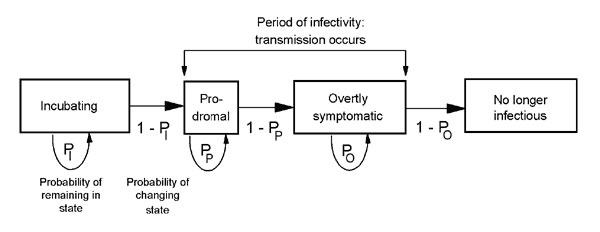Volume 7, Number 6—December 2001
Research
Modeling Potential Responses to Smallpox as a Bioterrorist Weapon
Figure 1

Figure 1. Schematic of the Markov-chain model used to model the movement of a person infected with smallpox through the four stages of disease. PI = probability of remaining in the incubating stage; PP = probability of remaining in the prodromal stage; and PO = probability of remaining in the overtly symptomatic stage. For each stage, the probabilities of remaining in that stage (PI,PP,PO) are determined by a daily probability (Figure 2). Patients who have reached the fourth and final stage (no longer infectious) effectively drop out of the model. The "overtly symptomatic" stage refers to the period of disease when a person has a rash or similar symptoms that even an untrained observer can readily note. During the period of infectivity, the average number of persons infected per infectious patient is preset by the researchers. The days when transmissions occur are determined by a probability function.
1Others have suggested that the terms "preeruptive" or "initial" are more descriptively accurate of this stage (6). However, because "prodromal" is used in many standard textbooks (7,8,17), we will use this term.
2Prodromal rashes have been recorded, but they were considered to be uncommon occurrences, ". . . not more than 1 in 10." (17).
3The United States stopped routine vaccination of the civilian population in 1972 (5). In July 1998 in the United States, there were approximately 109.9 million persons <30 years of age, representing 41% of the total resident population (20). Most of these people have not been vaccinated against smallpox. In addition, the immunologic status of those who were vaccinated >30 years ago must be considered. Historical data indicate that vaccination 20 to 30 years ago may not protect against infection but will often protect against death (8,21). No reports, however, define the probability of such persons' transmitting the disease to susceptible persons. Faced with such uncertainty, we chose the simplest approach of assuming an unlimited supply of susceptible persons.
4At a 50% daily removal rate, a cohort of all those beginning the first day of overt symptoms is entirely removed in 7 days (8 to 10 days postincubation), with 90% removed in 4 days after they enter the overtly symptomatic period. At a 25% daily removal rate, a cohort is entirely removed 17 days after entering the overtly symptomatic period (18 to 20 days postincubation), with 90% removed in 9 days after entering the overtly symptomatic period. The calculated numbers of those quarantined relate only to those who are infectious (i.e., overtly symptomatic). The model does not take into account those who might also be quarantined along with the infectious persons, such as unvaccinated household contacts and other exposed persons.
5The number, severity, and cost of vaccine-induced side effects is the subject for a separate paper.
6Allowing 3 days for laboratory confirmation assumes that virus loads in clinical specimens may be insufficient to allow use of rapid assays and confirmation must await the results of a culture-based assay, which takes approximately 72 hours. Rapid laboratory confirmation, within 24 hours, is possible.
7Even by reducing transmission from 3 to 2 persons per infectious person and quarantining infectious persons at a rate of 25% per day, the number of new cases at day 365 is 3, not zero (i.e., transmission is not quite completely stopped) (Figure 6). For transmission to cease completely, vaccination must either achieve a 38% reduction in transmission to 1.85 cases per infectious person (assuming a daily quarantine rate of 25%), or quarantine must achieve a 29% daily reduction in the number of infectious persons (assuming vaccination reduces transmission by 33%).
8Although there are some historical data regarding how infected persons interacted and infected others, all such data were collected when circumstances differed from those of today's societies, particularly with regard to travel and spread of information. Although air and other modes of mass travel were common before smallpox was eradicated, the numbers of travelers and the total miles traveled have vastly increased in the past 30 years. Similarly, although mass media were well known and used in the 1960s and 1970s, more outlets are available to spread information than ever before. It is unknown how these and other changes could affect the spread of smallpox.